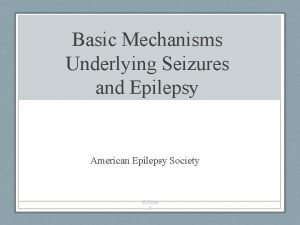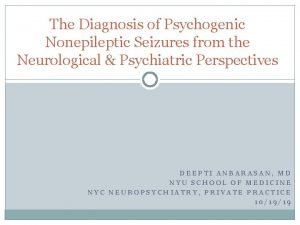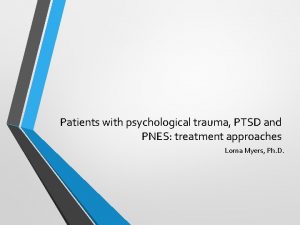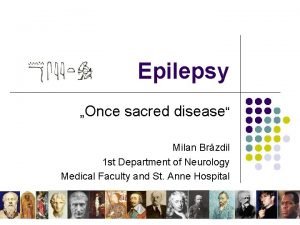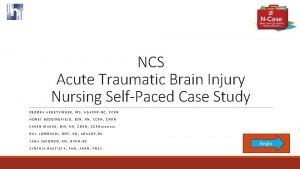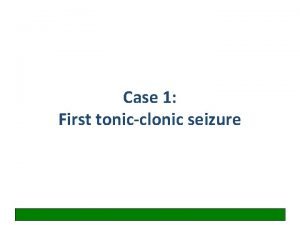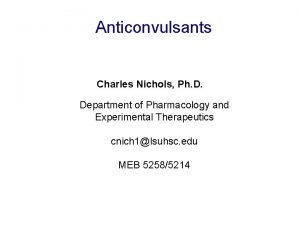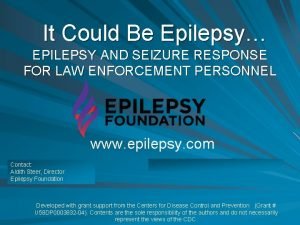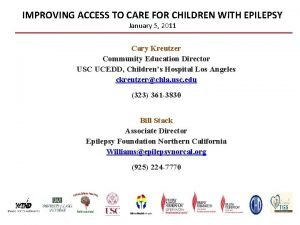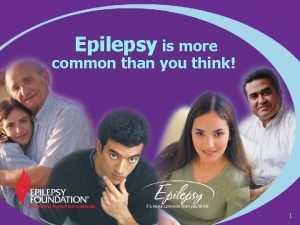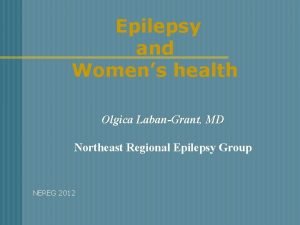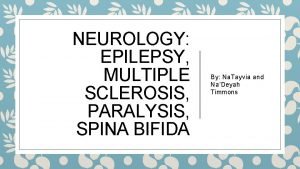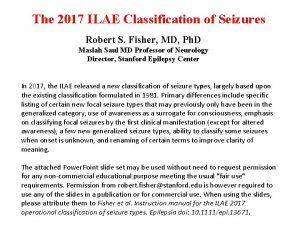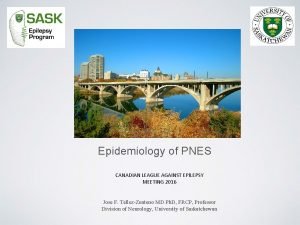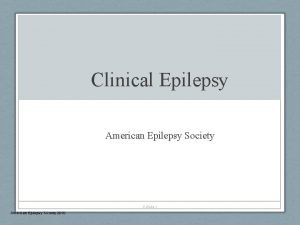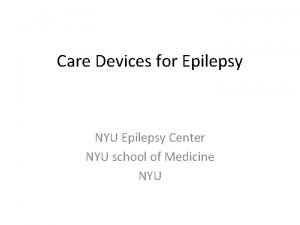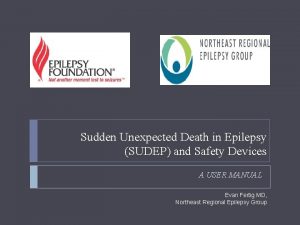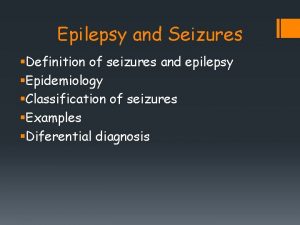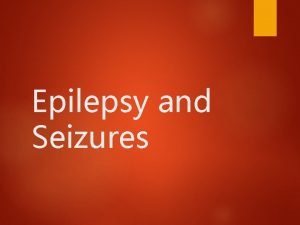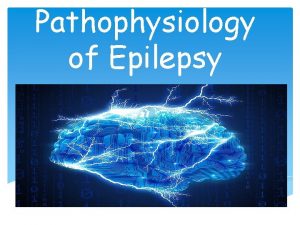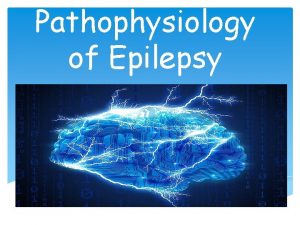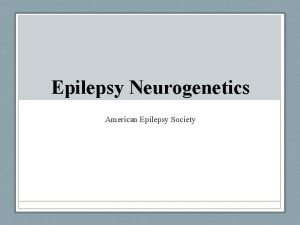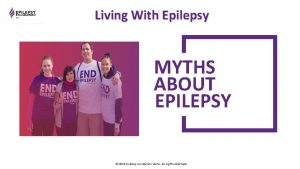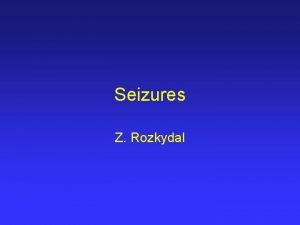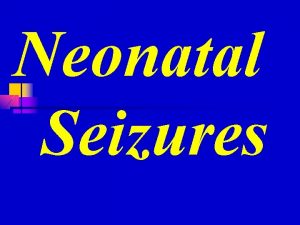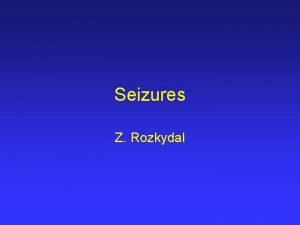Seizures and Epilepsy Introduction Craig Watson M D





























- Slides: 29

Seizures and Epilepsy: Introduction Craig Watson, M. D. , Ph. D. Professor of Neurology Wayne State University School of Medicine Founding Director, WSU/DMC Comprehensive Epilepsy Program



EPILEPSY EPIDEMIOLOGY I 50 per 100, 000 population per year (150, 000 cases per year) l Prevalence 1% of population (2. 5 million in USA) l Cumulative Incidence l 10% of population will have at least one seizure in their lifetime l 4% of population will have diagnosis of epilepsy l 1% will have a single unprovoked seizure l 3% will have a seizure due to an acute brain or metabolic insult l 2 -5% will have febrile convulsion(s)


EPILEPSY EPIDEMIOLOGY II 60 -65% of all patients with epilepsy can be controlled with one or two AEDs l Only 40% of patients with partial seizures (with or without secondary generalization) are seizure-free * l 35 -40% are medically intractable l 60 -80% of patients with partial seizures are medically intractable* l 20 -30% of patients with intractable seizures are surgical candidates *VA I and II Studies l

EPILEPSY EPIDEMIOLOGY III: Detroit Metropolitan Area Population l All patients with epilepsy (1%) l Patients with partial seizures (60%) l Medically intractable epilepsy (40%) l Patients with partial seizures (60%) l Surgical Candidates (25%) l 5, 000 50, 000 30, 000 20, 000 18, 000 5, 000



















Which AEDs to Use: Partial Seizures w/wo GTCS Drugs of choice l l CBZ PHT Newer AEDs l l l Second line AEDs l l l VPA PB PRM l l LTG TPM OXC LEV ZNS PGB LCM Second line AEDs l l GBP TGB

Which AEDs to Use: Primary Generalized Epilepsy Drugs of choice l Simple absence (CAE) VPA l ESM l l GTCS VPA l CBZ l PHT l l Mixed PGE l VPA Newer AEDs l l LTG TPM LEV ZNS

Identification and Treatment of Refractory Epilepsy l l l l Goal: Maintenance of normal lifestyle by complete seizure control with no side effects (65% of patients with newly diagnosed epilepsy) Accurate classification of seizure type(s) and epilepsy syndrome Failure to respond to 1 st AED (only 11% become Sz-free) Failure to respond to 2 first line AEDs (only 4% become Sz-free) Consider (“synergistic”) dual AED therapy (only 3% become Sz-free) Consider resective epilepsy surgery (especially if HS or lesion present) Consider VNS if not a surgical candidate Kwan & Brodie. NEJM 342: 314 -319, 2000 Brodie & Kwan. Neurology 58 (suppl 5): S 2 -S 8, 2002 Kwan & Brodie. Seizure 11: 77 -84, 2002

AED Acronyms Established AEDs l l l Phenytoin (PHT) Carbamazepine (CBZ) Valproic acid (VPA) Phenobarbital (PB) Primidone (PRM) Ethosuximide (ESM) Newer AEDs l l l l l Gabapentin (GBP) Lamotrigine (LTG) Topiramate (TPM) Tiagabine (TGB) Oxcarbazepine (OXC) Levetiracetam (LEV) Zonisamide (ZNS) Pregabalin (PGB) Lacosamide (LCM)
 Basic mechanisms underlying seizures and epilepsy
Basic mechanisms underlying seizures and epilepsy Craig watson md phd
Craig watson md phd James broadus watson
James broadus watson John broadus watson emma watson
John broadus watson emma watson John b watson conductismo
John b watson conductismo Mary ickes watson
Mary ickes watson Classification of anticonvulsant drug
Classification of anticonvulsant drug Non epileptic seizures
Non epileptic seizures Pediatric seizures
Pediatric seizures Ptsd seizures
Ptsd seizures Psychomotor seizures
Psychomotor seizures Psychomotor seizures
Psychomotor seizures Subclinical seizures eeg
Subclinical seizures eeg Nursing care plan for headache slideshare
Nursing care plan for headache slideshare Seizures
Seizures Pimidone
Pimidone Tonic vs clonic
Tonic vs clonic What to do if someone has a seizure
What to do if someone has a seizure Types of febrile seizures
Types of febrile seizures Simple partial seizures vs complex
Simple partial seizures vs complex What is a seizure
What is a seizure Epilepsy
Epilepsy Difference between seizure and epilepsy
Difference between seizure and epilepsy Catamenial epilepsy and birth control pills
Catamenial epilepsy and birth control pills Spina bifida and epilepsy
Spina bifida and epilepsy Seizure types and symptoms
Seizure types and symptoms Canadian league against epilepsy
Canadian league against epilepsy Syncope vs seizure
Syncope vs seizure Nyu epilepsy center
Nyu epilepsy center Emfit epilepsy alarm manual
Emfit epilepsy alarm manual
